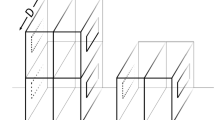Abstract
The heat generated in buildings and the manner in which this heat is exchanged with the ambient environment can play an important role in urban climate. Recent studies have shown that anthropogenic heat from air-conditioning facilities can increase the exterior ambient temperature and should be taken into account for a more complete urban heat island (UHI) mitigation study. For this purpose, the first part of the present work is focused on the coupling of a new building energy model (BEM) and an urban canopy parameterisation (UCP). The new scheme is implemented in a finite volume mesoscale model (MM) and tested in a two-dimensional (2D) configuration of a city over flat terrain. A sensitivity study is performed with respect to different parameters in order to test the simulation system and enhance the understanding of the possible impacts of the BEM on the exterior microclimate.
Similar content being viewed by others
References
Arnfield AJ, Grimmond CSB (1998) An urban canopy energy budget model and its application to urban storage heat flux modelling. Energy Build 27: 61–68
Ashie Y, Vu Thanh C, Takashi A (1999) Building canopy model for the analysis of urban climate. J Wind Eng Ind Aerodyn 81: 237–248
Clappier A, Perrochet P, Martilli A, Muller F, Krueger BC et al (1996) A new non-hydrostatic mesoscale model using a CVFE (control volume finite element) Discretisation technique. In: Borrell PM (eds) Proceedings of EUROTRAC symposium ’96. Mech Publication, Southampton, pp 527–531
Clarke JA (1985) Energy simulations in building design. Adam Hilger, Bristol, p 384
Dupont S, Otte TL, Ching JKS (2004) Simulation of meteorological fields within and above urban and rural canopieswith a mesoscale model (MM5). Boundary-Layer Meteorol 113(1): 11–58
Grimmond CSB (2007) Urbanization and global environmental change: local effects of urban warming. Geogr J 173: 83–88
Grimmond CSB, Oke TR (2000) Aerodynamic properties of urban areas derived from analysis of surface form. J Appl Meteorol 38: 1262–1295
Jacobs A, Nicol F, Wilson M, Solomon J (2005) CLEAR, a multi-media package for Comfortable Low Energy Architecture. In: International conference “passive and low energy cooling for the built environment”, Santorini, Greece, pp 305–308
Kikegawa Y, Genchi Y, Yoshikado H, Kondo H (2003) Development of a numerical simulation system toward comprehensive assessments of urban warming countermeasures including their impact upon the urban buildings’ energy-demands. Appl Energy 76: 449–466
Kikegawa Y, Genchi Y, Kondo H, Hanaki K (2006) Impacts of city-block-scale countermeasures against urban heat island phenomena upon a building’s energy-consumption for air conditioning. Appl Energy 83: 649–668
Kusaka H, Kondo H, Kikegawa Y, Kimura F (2001) A simple single-layer urban canopy model for atmospheric models: comparison with multi layer and slab models. Boundary-Layer Meteorol 101: 329–358
Louis JF (1979) A parametric model of vertical eddies fluxes in the atmosphere. Boundary-Layer Meteorol 17: 187–202
Martilli A (2002) Numerical study of urban impact on the boundary layer structure: sensitivity to wind speed and urban morphology, and rural soil moisture. J Appl Meteorol 41: 1247–1267
Martilli A, Clappier A, Rotach MW (2002) An urban surface exchange parameterization for mesoscale models. Boundary-Layer Meteorol 104: 261–304
Martilli A, Roulet Y-A, Junier M, Rotach MW, Clappier A (2003) On the impact of urban exchange parameterisation on air quality simulations: the Athens case. Atmos Environ 37: 4217–4231
Masson V (2000) A physically-based scheme for the urban energy budget in atmospheric models. Boundary-Layer Meteorol 94: 357–397
Masson V, Grimmond CSB, Oke TR (2002) Evaluation of the Town Energy Balance (TEB) scheme, with direct measurements from dry districts in two cities. J Appl Meteorol 41: 1011–1026
Oke TR (1987) The surface energy budget on urban areas. In Modeling the Urban Boundary Layer. AMS. ISBN: 0-933876-68-8, pp 1–52
Ratti C, Di Sabatino S, Britter R, Brown M, Caton F, Burian S (2002) Analysis of 3-D urban databases with respect to pollution dispersion for a number of European and American cities. Water Air Soil Pollut Focus 2: 459–469
Roulet C-A (1987) Energétique du bâtiment II, Presses Polytechniques romandes, Lausanne, Switzerland, 144 pp
Roulet Y-A (2004) Validation and application of an urban turbulence parameterisationscheme for mesoscale atmospheric models. PhD thesis No. 3032, Swiss Federal Institute of Technology, Lausanne
Roulet Y-A, Martilli A, Rotach MW, Clappier A (2005) Validation of an urban surface exchange parameterization for mesoscale models −1D case in a street canyon. J Appl Meteorol 44: 1484–1498
Salamanca F, Martilli A (2009) A new building energy model coupled with an urban canopy parameterization for urban climate simulations—part II. Validation with one dimension off-line simulations. Theor Appl Climatol. doi:10.1007/s00704-009-0143-8
Salamanca F, Krpo A, Martilli A, Clappier A (2009) A new building energy model coupled with an urban canopy parameterization for urban climate simulations—part I. Formulation, verification and sensitivity analysis of the model. Theor Appl Climatol. doi:10.1007/s00704-009-0142-9
Author information
Authors and Affiliations
Corresponding author
Rights and permissions
About this article
Cite this article
Krpo, A., Salamanca, F., Martilli, A. et al. On the Impact of Anthropogenic Heat Fluxes on the Urban Boundary Layer: A Two-Dimensional Numerical Study. Boundary-Layer Meteorol 136, 105–127 (2010). https://doi.org/10.1007/s10546-010-9491-2
Received:
Accepted:
Published:
Issue Date:
DOI: https://doi.org/10.1007/s10546-010-9491-2




